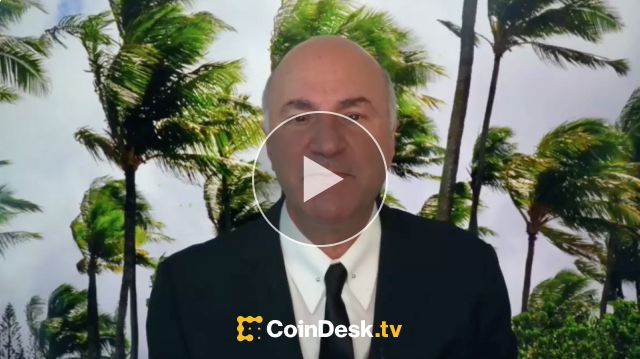Kevin O’Leary is a centimillionaire, a businessperson on reality TV and a crypto bag holder. He’s one of many, many traditional investors with public profiles to make big moves into the crypto market last year during the biggest run-up to date. He’s invested in startups, draws yields by staking his stablecoins and has allocations across 32 different cryptocurrencies, he said on CoinDesk TV Tuesday morning.
“Multiple equities, multiple tokens, multiple coins, multiple blockchains,” O’Leary told the “First Mover” hosts. “I own so many of them.”
This article is excerpted from The Node, CoinDesk’s daily roundup of the most pivotal stories in blockchain and crypto news. You can subscribe to get the full newsletter here.
O’Leary, 67 and born in Canada, has made a career out of investing. But it’s not just his job, it’s his persona. He’s “Mr. Wonderful”. He’s a shark who invests in cupcake companies. He’s the guy who calls it as he sees it: Investments either win or lose. It’s that “binary.”
Yet, when it comes to crypto, O’Leary is an advocate for diversification. He says his largest holding today is ETH, the native currency of the Ethereum network, and he has also bought BTC, SOL, MATIC and 28 other coins. Likewise, seeing crypto exchanges as potentially lucrative, he sees a world where both decentralized and centralized exchanges can win.
Last week, his decentralized finance play, WonderFi, bought a regulated Canadian exchange in a cash and stock deal.
“In my world, I can go all the way to 20% in crypto, and within that subset no position will be larger than 5%,” he said. “That is a very sound mandate of diversification. You will get the rise of crypto. Not all will be equal. … I’m not going to get wrecked if one 5% position goes to zero.”
Although spread wide, O’Leary says these investments are not random. Drawing a comparison to Microsoft and Google, he views cryptocurrencies as “productivity software.” Bitcoin is not a coin, there’s no physical counterpart, it’s code, he said. Likewise for tools like Polygon, which is trying to bolster Ethereum’s lackluster throughput. He doesn’t “play” with meme coins, favoring “real productivity.”
“I don’t know which of these platforms is going to win. That’s why I own them all,” he said. “I’m investing in the long-term future of a global enterprise.”
That’s a fine statement for a millionaire to make, but probably unrealistic for the many everyday people looking to bet on crypto. But it’s consistent with Mr. Wonderful’s view of the industry. Among crypto fanatics there’s a large emphasis on bitcoin being a tool of personal responsibility. Bitcoiners advocate self-reliance, self-custody and the self-management of time horizons.
But for O’Leary, crypto is better seen as a sub-sector of the largest economy. He proffered a phrase, “the 12th sector of the S&P,” referring to the Standard & Poor’s 500 stock index, for his vision of mass adoption. “The real potential of crypto is not just an individual’s, it’s institutional capital,” he said. “You need to attract it.”
Indeed, as O’Leary notes, “the smartest hands over the keyboard now are in crypto.” Venture and regular old capitalists have plowed “billions of dollars” into crypto the past two years.
Recently, there has been something of a populist revolt against this trend. Block CEO Jack Dorsey, Signal founder Moxie Marlinspike and countless others have spoken out against the presence of large crypto bagholders in the market who tilt the scale and potentially reintroduce centralization into supposedly decentralized tech. Although rich themselves, they represent a real view.
Read more: What Jack Dorsey’s Beef With ‘Web 3′ Is Really About | Opinion
Millennial market commentator Kyla Scanlon wrote just yesterday about this “narrative” war. Web 3 is also likely to be interpreted as “a promenade of wealth” as “an equitable, cooperative, and accessible” version of the web that the tech presents.
O’Leary, again, straddles the binary. Decentralized finance can make markets more transparent, resilient and less expensive, he said, but the benefits will probably accrue to the top. “You’re going to see massive amounts of institutional capital come into this because of the economic value,” he said.
That is, if we can just get a little regulatory clarity, O’Leary said. He shared the story of what happened to his capital gains from investing in real estate after he exited the market. Instead of parking his cash at a bank where he’d lose buying power due to inflation, he wanted a stake in the dollar-pegged stablecoin USDC on FTX (a crypto exchange he’s invested in and is a paid spokesperson for).
It took six months to set the arrangement up, and it’s still less than ideal. “Within my own compliance department, they do not consider stablecoins cash, they consider it equity” so he can’t hold more than 5% due to compliance concerns.
“Right now I need, I really need, the regulator to make policy on stablecoin,” he said, referring to the asset class in the singular.
This isn’t the first time O’Leary has called for regulations. Last year, he played a major role in drumming up environmental concerns against bitcoin, saying that for institutions to get involved they need an ESG-friendly option. Regulation is needed, as are eco-friendly miners to create distinct versions of clean and dirty bitcoin.
O’Leary is a skilled investor and spokesperson. But does the industry need more investors like Mr. Wonderful?














